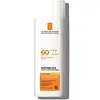What's inside
What's inside
 Key Ingredients
Key Ingredients

 Benefits
Benefits

 Concerns
Concerns

 Ingredients Side-by-side
Ingredients Side-by-side

Butyl Methoxydibenzoylmethane 5%
UV AbsorberEthylhexyl Triazone 5%
UV AbsorberOctocrylene 3%
UV AbsorberBis-Ethylhexyloxyphenol Methoxyphenyl Triazine 1%
Skin ConditioningPhenoxyethanol
PreservativeC12-15 Alkyl Benzoate
AntimicrobialAloe Barbadensis Leaf Juice
Skin ConditioningMagnesium Aluminum Silicate
AbsorbentCetearyl Alcohol
EmollientDibutyl Adipate
EmollientDimethicone
EmollientTocopheryl Acetate
AntioxidantTetrasodium EDTA
Hydroxyacetophenone
AntioxidantCI 77491
Cosmetic ColorantCI 77492
Cosmetic ColorantPolyglyceryl-3 Diisostearate
EmulsifyingWater
Skin ConditioningRice Bran Wax Ethyl Esters
AntioxidantSilicon
AbrasiveSodium Hyaluronate
HumectantStearic Acid
CleansingTriethanolamine
BufferingXanthan Gum
EmulsifyingButyl Methoxydibenzoylmethane 5%, Ethylhexyl Triazone 5%, Octocrylene 3%, Bis-Ethylhexyloxyphenol Methoxyphenyl Triazine 1%, Phenoxyethanol, C12-15 Alkyl Benzoate, Aloe Barbadensis Leaf Juice, Magnesium Aluminum Silicate, Cetearyl Alcohol, Dibutyl Adipate, Dimethicone, Tocopheryl Acetate, Tetrasodium EDTA, Hydroxyacetophenone, CI 77491, CI 77492, Polyglyceryl-3 Diisostearate, Water, Rice Bran Wax Ethyl Esters, Silicon, Sodium Hyaluronate, Stearic Acid, Triethanolamine, Xanthan Gum
Butyl Methoxydibenzoylmethane 3%
UV AbsorberHomosalate 10%
Skin ConditioningEthylhexyl Salicylate 5%
UV AbsorberOctocrylene 7%
UV AbsorberWater
Skin ConditioningCyclopentasiloxane
EmollientAlcohol Denat.
AntimicrobialSilica
AbrasiveDicaprylyl Ether
EmollientStyrene/Acrylates Copolymer
PEG-30 Dipolyhydroxystearate
EmulsifyingDimethicone
EmollientCyclohexasiloxane
EmollientPolymethylsilsesquioxane
Nylon-12
Dicaprylyl Carbonate
EmollientDiethylhexyl Syringylidenemalonate
Skin ProtectingPhenoxyethanol
PreservativeLauryl PEG/PPG-18/18 Methicone
Skin ConditioningSodium Chloride
MaskingCaprylyl Glycol
EmollientPEG-8 Laurate
EmulsifyingIsostearyl Alcohol
EmollientPoly C10-30 Alkyl Acrylate
Emulsion StabilisingDisteardimonium Hectorite
StabilisingP-Anisic Acid
MaskingCaprylic/Capric Triglyceride
MaskingDisodium EDTA
Cassia Alata Leaf Extract
AstringentPropylene Carbonate
SolventSodium Dodecylbenzenesulfonate
CleansingTocopherol
AntioxidantButyl Methoxydibenzoylmethane 3%, Homosalate 10%, Ethylhexyl Salicylate 5%, Octocrylene 7%, Water, Cyclopentasiloxane, Alcohol Denat., Silica, Dicaprylyl Ether, Styrene/Acrylates Copolymer, PEG-30 Dipolyhydroxystearate, Dimethicone, Cyclohexasiloxane, Polymethylsilsesquioxane, Nylon-12, Dicaprylyl Carbonate, Diethylhexyl Syringylidenemalonate, Phenoxyethanol, Lauryl PEG/PPG-18/18 Methicone, Sodium Chloride, Caprylyl Glycol, PEG-8 Laurate, Isostearyl Alcohol, Poly C10-30 Alkyl Acrylate, Disteardimonium Hectorite, P-Anisic Acid, Caprylic/Capric Triglyceride, Disodium EDTA, Cassia Alata Leaf Extract, Propylene Carbonate, Sodium Dodecylbenzenesulfonate, Tocopherol
 Reviews
Reviews

Alternatives
Ingredients Explained
These ingredients are found in both products.
Ingredients higher up in an ingredient list are typically present in a larger amount.
Also known as Avobenzone, this ingredient is a chemical sunscreen filter that provides protection in the UV-A range.
Avobenzone is globally approved and is the most commonly used UV-A filter in the world.
Studies have found that avobenzone becomes ineffective when exposed to UV light (it is not photostable; meaning that it breaks down in sunlight). Because of this, formulations that include avobenzone will usually contain stabilizers such as octocrylene.
However, some modern formulations (looking at you, EU!) are able to stabilize avobenzone by coating the molecules.
Avobenzone does not protect against the UV-B range, so it's important to check that the sunscreen you're using contains other UV filters that do!
The highest concentration of avobenzone permitted is 3% in the US, and 5% in the EU.
Learn more about Butyl MethoxydibenzoylmethaneDimethicone is a type of synthetic silicone created from natural materials such as quartz.
What it does:
Dimethicone comes in different viscosities:
Depending on the viscosity, dimethicone has different properties.
Ingredients lists don't always show which type is used, so we recommend reaching out to the brand if you have questions about the viscosity.
This ingredient is unlikely to cause irritation because it does not get absorbed into skin. However, people with silicone allergies should be careful about using this ingredient.
Note: Dimethicone may contribute to pilling. This is because it is not oil or water soluble, so pilling may occur when layered with products. When mixed with heavy oils in a formula, the outcome is also quite greasy.
Learn more about DimethiconeOctocrylene protects skin from sun damage. It absorbs UV-B with peak absorption of 304 nm. It is a common sunscreen ingredient and often paired with avobenzone, a UVA filter. This is because octocrylene stabilizes other sunscreen ingredients by protecting them from degradation when exposed to sunlight. Octocrylene is a photostable ingredient and loses about 10% of SPF in 95 minutes.
Octocrylene also acts as an emollient, meaning it helps skin retain moisture and softens skin. It is oil-soluble and hydrophobic, enhancing water-resistant properties in a product.
Those who are using ketoprofen, a topical anti-inflammatory drug, may experience an allergic reaction when using octocrylene. It is best to speak with a healthcare professional about using sunscreens with octocrylene.
The EU allows a maximum of these concentrations:
Learn more about OctocrylenePhenoxyethanol is a preservative that has germicide, antimicrobial, and aromatic properties. Studies show that phenoxyethanol can prevent microbial growth. By itself, it has a scent that is similar to that of a rose.
It's often used in formulations along with Caprylyl Glycol to preserve the shelf life of products.
Water. It's the most common cosmetic ingredient of all. You'll usually see it at the top of ingredient lists, meaning that it makes up the largest part of the product.
So why is it so popular? Water most often acts as a solvent - this means that it helps dissolve other ingredients into the formulation.
You'll also recognize water as that liquid we all need to stay alive. If you see this, drink a glass of water. Stay hydrated!
Learn more about Water